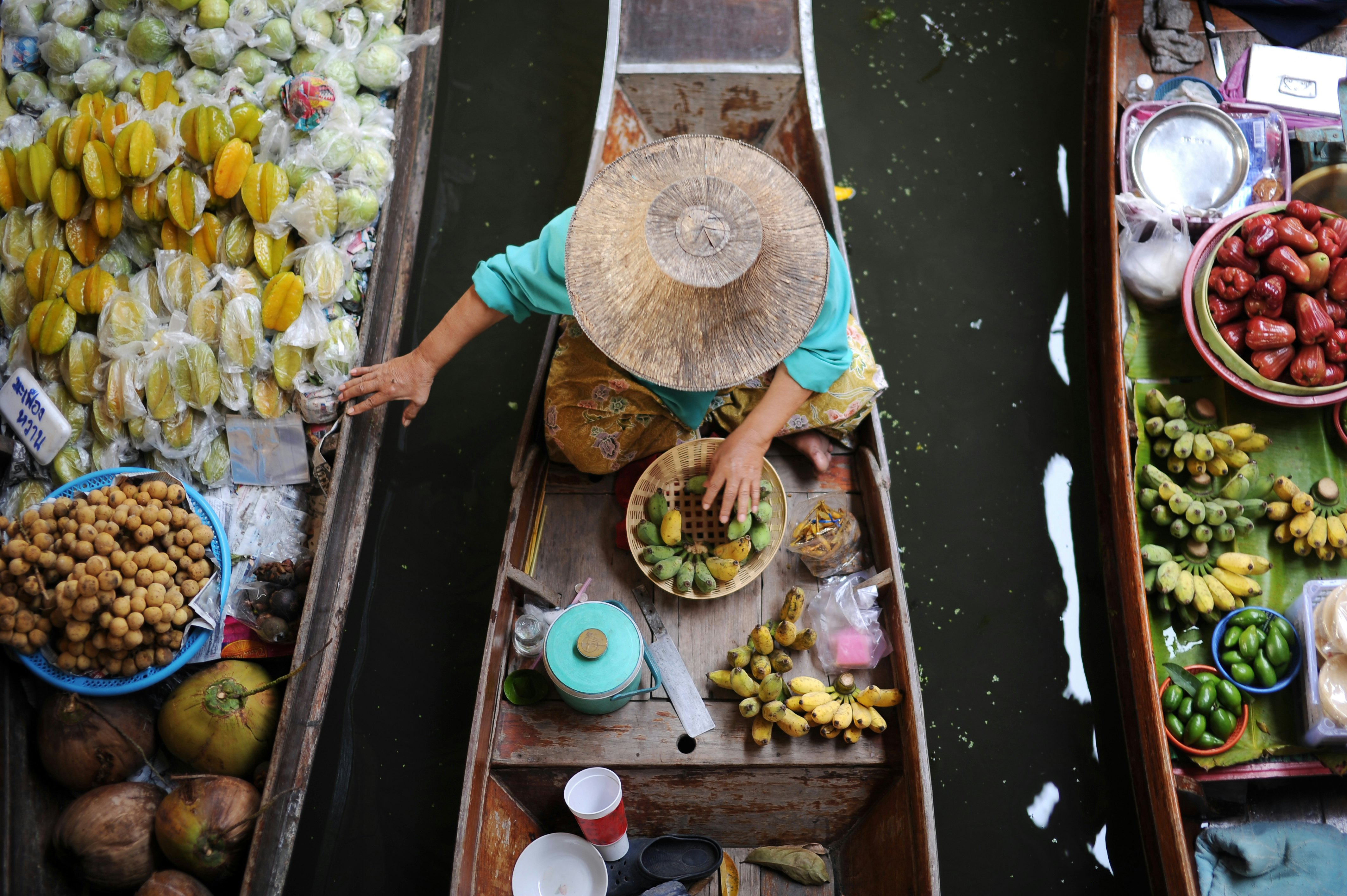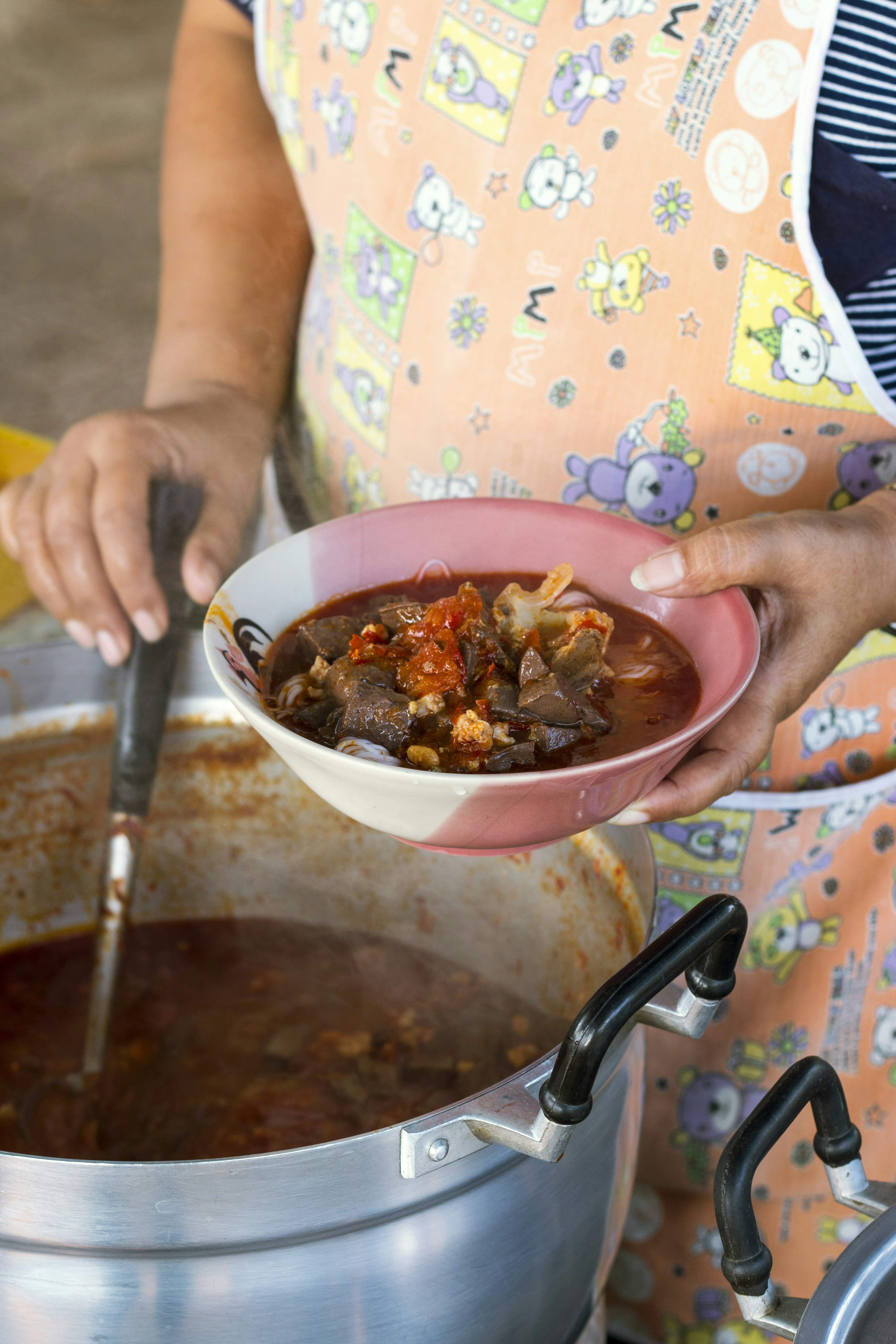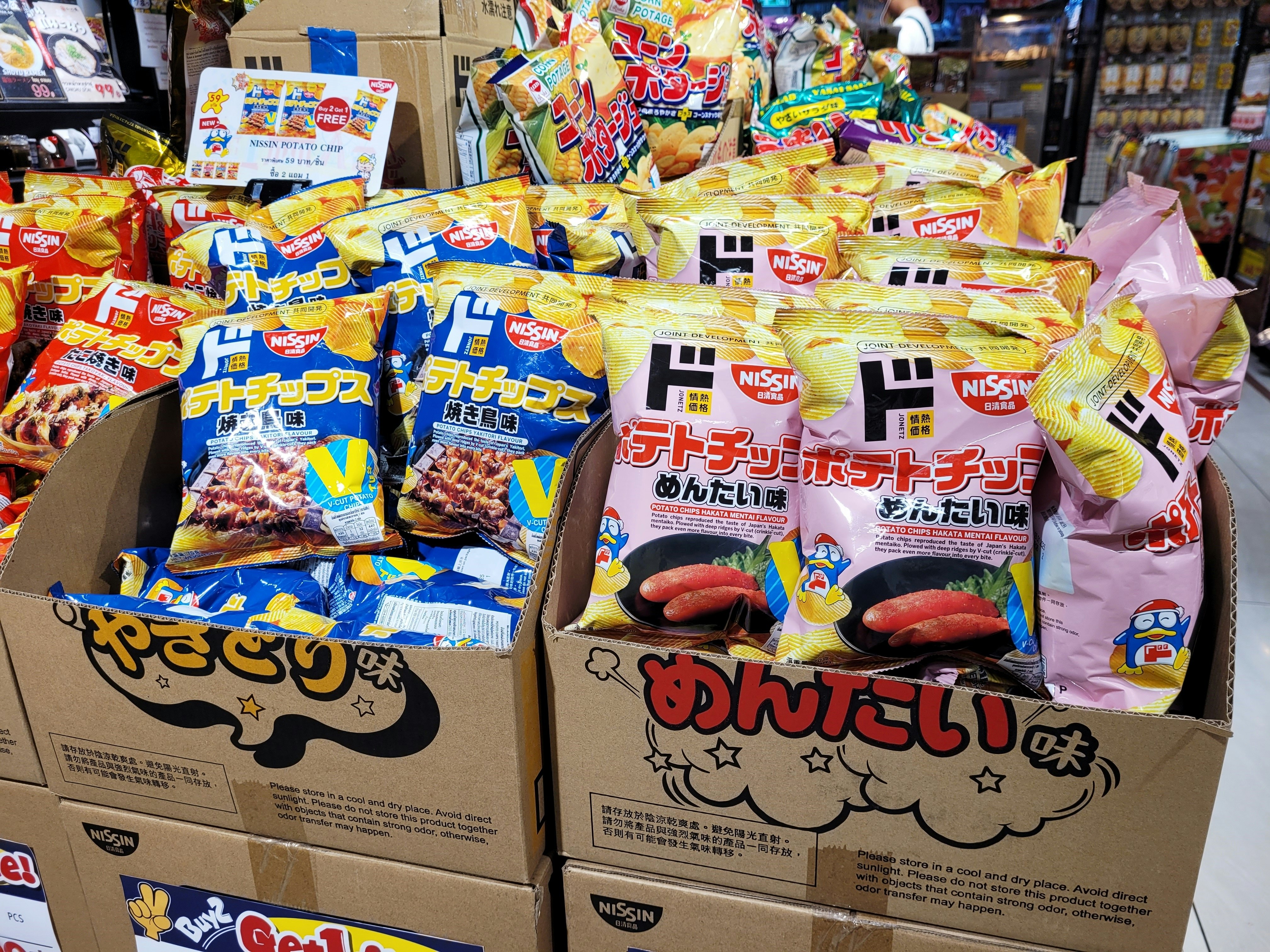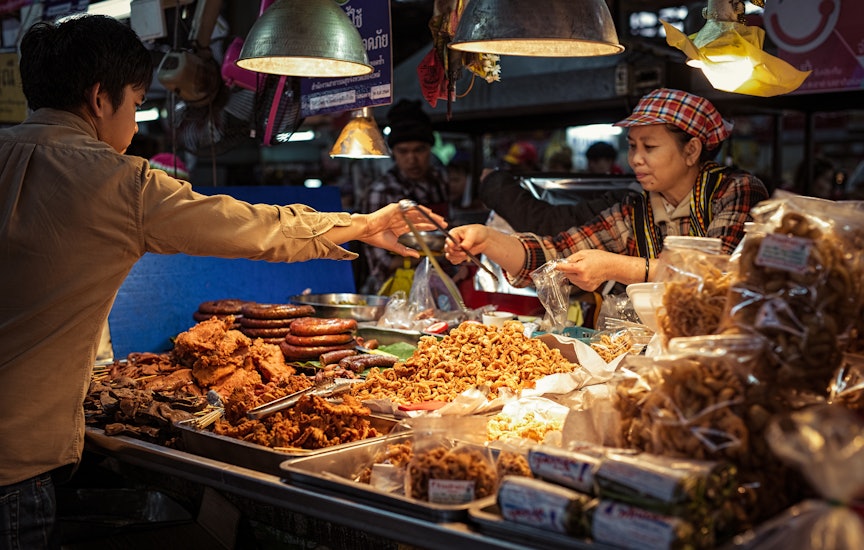
A food writer's guide to shopping for Thai food like a local

Jul 31, 2025 • 10 min read

The meat market at the Khlong Toey Market in Bangkok. amnat30/Shutterstock
Chawadee Nualkhair is a food writer specializing in street food and has written food-focused guidebooks spanning the length of Thailand, including the third edition of "Thailand's Best Street Food," as well as a recent cookbook, "Real Thai Cooking". She also appeared on a number of TV shows, including the Bangkok episodes of "Street Food Asia" and "Somebody Feed Phil" on Netflix.
People often say that to truly know Thailand, you must eat like the locals, not just on the streets but also by shopping for ingredients the way they do – in bustling markets, supermarkets and specialty stores. Each shopping experience offers a unique insight into Thai culture and cuisine, particularly local wet and floating markets, which are often microcosms of the neighborhoods that they serve.
After all, what traveler hasn’t filled their Instagram feeds with shots of the beautiful produce at Mercat de la Boqueria in Barcelona? The box-shaped, wildly expensive melons in the basement of Mitsukoshi in Tokyo? Or the geoducks and hairy crabs at a seafood market in Hong Kong? Markets provide intimate glimpses into other lives and tables, informal tours that are only as expensive and lengthy as you want them to be.
When shopping for food in Thailand, you can explore not just the ingredients that define Thai food but also the subtle quirks that reflect the character of each market, supermarket and grocery store you visit. This is not just a shopping trip; it’s an immersive journey into the heart of Thai food culture.

Where to get your Thai foodie fix
Thailand’s many night markets remain places for tourists and locals alike seeking a fun night out with cheap food, gimmicky snacks like “dancing shrimp” (baby shrimp tossed in a spicy dressing), and bucket cocktails. In contrast, floating markets offer a more varied food experience (particularly fruit and ready-to-go snacks like mango sticky rice) and are far more authentic, as well.

Wet markets
The most popular place among Thais to buy their groceries remains the open-air market. Referred to occasionally as the “wet market” because of the perishable goods (and smaller livestock) that make up most of their inventory, open-air markets can be found in every Thai neighborhood throughout the kingdom. Each market caters exclusively to its own clientele, so there are subtle (and sometimes not-so-subtle) differences between them. If one were to pinpoint the One Market to Rule Them All, it would be Klong Toei, the nearly-24-hour destination in central Bangkok that serves as the beating heart for the capital’s food scene, which offers everything from curry pastes and fresh vegetables to flapping fish and live frogs. For more high-end items, Bangkok’s affluent residents like Or Tor Kor, where fruit comes individually wrapped. And if prepared foods are what you are looking for, Nang Loeng Market appeals to even the most persnickety of Thai foodies, selling handmade traditional sweets, old-fashioned snacks and impeccable ready-made curries to eat in or take home.
Supermarkets
For a less chaotic experience, many locals prefer large supermarkets, known as “supers” in Thai. These range from upscale options like Central Food Hall (great for Christmas crackers and panettone), Gourmet Market (ideal for Japanese and Korean products) and Villa Market (for American goods), to mid-range choices like Tops and Foodland (open 24 hours), and budget-friendly spots like Big C and wholesaler Makro (membership required). For those seeking Japanese specialties, UFM Fuji Super is Thailand’s only supermarket dedicated entirely to Japanese products, including natto (fermented soybeans).
Convenience stores
If you’re only after basics like milk or eggs, convenience stores are everywhere. 7-Eleven, with over 14,000 outlets across Thailand, offers essentials like milk, bread, and water, along with quick snacks like hard-boiled eggs, instant noodles and toasted ham-and-cheese sandwiches.
International foods
Bangkok’s diverse neighborhoods bring international flavors to your fingertips. In areas with large Japanese expat communities, stores like Lawson and Family Mart also offer Japanese favorites like onigiri (rice balls) and oden (hot pot). In Chinatown, you’ll find markets selling controversial items like shark’s fin, bird’s nest and ingredients for traditional Chinese medicine. On Soi Arab (Sukhumvit 3/1), shops offer oud and shisha pipes, while Little India (Pahurat) features spices like Indian cardamom and curry leaves, along with sweets like gulab jamun and samosas.
How to shop like a Thai
Products, especially in Thai wet markets, are highly seasonal and local. During the summer (March and April), fruit like mangoes, mangosteens and durian are at their peak. The rainy season (May to October) brings cheap limes, milder chilies and an abundance of bamboo shoots – and if you’re lucky, fiddlehead ferns (pak kood). In the cool season (November to February), expect an abundance of citrus fruits and fresh herbs like coriander and dill.
Regional markets have their own specialties. In the North and Northeast, the rainy season produces hed proh (false earthstar mushrooms), highly prized for their explosive flavor, along with ant larvae and glossy ants, said to taste like coconut milk.
The cool season heralds freshly harvested rice across the country. In the far North, you can find strawberries, figs and even peaches, while in the far South, with its Muslim-Thai majority, dishes like khao yum (herbal Thai rice salad) and turmeric-brushed grilled fish are abundant.
One of the best parts of any market in Thailand is the food court. Almost every market has a collection of vendors offering simple noodles, fried snacks or sweets, usually within walking distance of supermarkets. After all, shopping is hard work, and in Thailand it’s rare to go more than half an hour without some sort of snack.

Thai must-buy products
Fresh herbs and spices
If your customs officials allow it, Thai food lovers should consider bringing home three key ingredients that are foundational to many Thai dishes: makrut (or kaffir) lime leaves, lemongrass and galangal. While these may be available in your local markets, they’re much cheaper in Thailand and freeze well. Other excellent herbs and spices include wild grachai (wild ginger), perfect for seafood; prik Thai aun (green peppercorns) ideal for jungle curry; and fresh turmeric for sour curry. You can find these at wet markets or, at higher prices, in supermarkets.
Thai curry pastes
Another great souvenir is Thai curry paste, which simplifies making Thai dishes at home. Along with the usual red, green and yellow curries, consider pastes for Penang, massaman or even gang som (sour curry). Brands like Lobo offer a wide selection, available almost everywhere in Thailand.

Thai pantry staples
Buying nam pla (fish sauce) in Thailand is significantly cheaper than at specialty stores abroad, with a wider variety of brands available. Bo.lan Grocer, run by the well-known restaurant Bo.lan, offers artisanal Thai ingredients, including fish sauce from Samut Songkhram and Rayong. If you can’t visit Bo.lan, supermarkets carry great brands like Megachef and Squid.
For soy sauce, Thailand offers both the common see ew khao (white soy sauce) and see ew dum (thick, dark soy sauce), ideal for sweet-and-sour stir-fries. Dek Somboo is arguably the most widely used soy sauce brand in Thailand.
Nam prik pao (roasted chilli jam) is not the first souvenir that people think of to bring home, but this versatile, umami-rich and slightly sweet condiment, usually made with shrimp, is great on pasta, in stir-fries and even mixed with cream cheese on a bagel. Look for the Maesri brand. Similarly, nam makham piek (tamarind juice) is a staple in Thai cooking for a sweet acidity that’s less harsh than lime juice and perfect for recreating the flavors of Thailand at home.
Meanwhile, nam tan peep (palm sugar) is prized for its mellower, more rounded sweetness compared to granulated sugar, and figures largely in traditional pad Thai. Many consider the palm sugar from the central Thai town of Phetchaburi to be the best in the country.

Fresh produce
The best fresh souvenirs are Thai fruits. Mangoes, especially the nam dok mai variety, are available year-round, though their peak season is March to April. Mangosteens, rambutans and lychees are also great options, much fresher and cheaper than what you’d find abroad.
Gourmet items: tinned products
Tinned goods are perfect for travel because they are lightweight and leak-proof. Maesri offers tinned curry pastes, while Roza provides Thai pantry staples like mackerel in tomato sauce. Canned fruits such as rambutan, lychee and toddy palm fruit (great over ice cream) also make for easy souvenirs.
Regional specialties
Outside Bangkok, you’ll find a variety of unique food items. In the North, markets like Talad Warorot in Chiang Mai sell buffalo rinds, pork rinds and chili paste dips like nam prik num and nam prik ong. You can also find makhwan, a Sichuan peppercorn-like spice with numbing qualities. In the Northeast, adventurous eaters can explore cow placenta, crickets and coconut grubs, but more accessible treats include jars of sato (rice wine).
In the East, particularly Chantaburi, durian (a spiky fruit with a strong smell) is king. While it is unlikely that airlines will allow you to bring this fruit onboard, tourists from all over Asia descend on Chantaburi town during the hot season to sample the few durians that haven’t been snapped up by grocers. In Si Racha, don’t miss the chance to buy the original Sriracha sauce, like Sriraja Panich, which is more complex than the version popular in the West. In the South, kapi (shrimp paste) is prized for its superior flavor, and coconut-based products, including bowls and utensils, make for unique souvenirs.

Snacks
What Kit-Kats are to Japan, potato chips are to Thailand. There are dozens of flavors in the kingdom that won’t be found anywhere else, including miang kham (the wrapped wild betel leaf snack), Northeastern Thai larb (the spicy minced meat salad), and Thai barbecue. Other good snacks include spicy fish strips from Taro, instant noodles from Mama (the shrimp tom yum flavor is an OG classic) and flavored macadamia nuts from Doi Tung (the wasabi ones are great).
Desserts and sweets
Though fresh Thai sweets don’t travel well, you can grab mango sticky rice at Suvarnabhumi International Airport. For longer-lasting options, packets of dried fruits like mango and mangosteen are easy to pack and widely available.

Unique finds
Thailand doesn’t have a strong tea culture, but there are many traditional tisanes made from medicinal ingredients, such as butterfly pea (for controlling blood sugar), roselle (for blood pressure) and bael fruit (for digestion).
Finally, no Thai kitchen is complete without a mortar and pestle. While granite sets are better for making pastes, they’re heavy to carry. A wooden set, ideal for salads like som tum, is a much easier souvenir to bring home.
Top tips for Thai food shopping
Shopping etiquette
Haggling in open-air markets and some specialty shops is typically OK, but it should go without saying that in supermarkets, the price is what it says on the sticker. Please remember that aggressive haggling – with raised voices or lots of gesticulation – is strictly taboo. If your offer is met with a shake of the head, simply go on to the next vendor; vendors selling vegetables, meat and so forth are typically grouped together in wet markets and sell similar ingredients.
Also in supermarkets, you may have to weigh your own fruit and meat and place the sticker on the items yourself. Cashiers are not able to do that for you. In higher-end supermarkets like Villa and Gourmet Market, someone is always on hand to work the weighing station, but you may have to actively seek out a helpful employee at places like Big C.
Best times to shop
Not surprisingly, weekends are the peak shopping times for Thais everywhere. To avoid the crowds, try 10am to 3pm on a weekday – these times are right before stores are able to sell alcohol (11am to 2pm and 5pm to midnight), when there is a bump in the number of people who shop. Keep in mind, no alcohol can be sold at all on Buddhist holidays and on election days (hotels are exempt from this rule).
Payment methods
In open-air markets and small neighborhood shops, cash is king, but if you happen to have a Thai bank account – or know someone who does – you can also transfer money directly to the vendor’s account in most cases. Otherwise, supermarkets and convenience stores honor credit and debit cards (unless the convenience store is a mom-and-pop shop, typically found along the perimeter of most wet markets).















